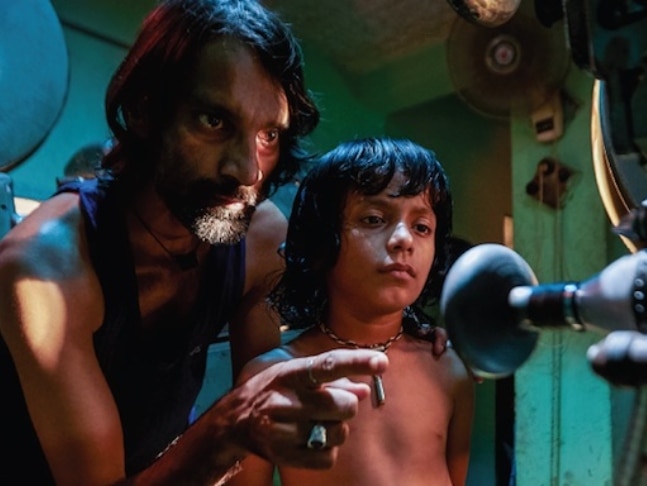Chhello Show review: India’s official Oscar entry is a moving tribute to projector-era cinema

Illustration by Geetanjali Singh for DailyO
Chhello Show AKA The Last Film Show is a Gujarati coming-of-age dramedy that began trending last month after it was announced as India’s official Oscar entry. While there was a little hype around exploring this under-the-radar film further, many in the country grew disappointed with Chhello Show pulling off an upset over the expected frontrunner RRR.
So, is Chhello Show better than RRR? That is a question we would address later. As for the Gujarati flick being deserving as an Oscar entry, it is definitely worth the honour.
The film is a Cinema Paradiso-influenced tribute to the art of not just moving pictures but also witnessing and appreciating them. Much like Cinema Paradiso’s Salvatore or Hugo’s titular protagonist, Chhello Show is led by a young pre-teen boy who simply falls in love with cinema at first sight.
The plot is also virtually inspired from Cinema Paradiso with the narrative centering on the friendship between a young boy and a projector operator. And yet Nalin’s execution doesn’t seem shamelessly derivative. Also, given that the drama takes place in a remote Gujarati town, the end product thankfully doesn’t come off as another poverty porn driven-Oscar bait.

Throughout the film, the audiences are prompted to view the world from the nine-year-old Samay who, after watching his first film, has made his life’s purpose to worship cinema and nothing else. But as he dwells in the small railroad town of Chalala, watching films is an exercise in itself. Every day, Samay takes the train to a neighbouring town that houses a government school. Even though he’s not a troublemaker as such, his rebellious tendencies come out when he bunks school to watch “talkies” at the local theatre.
When the theatre staff brands him as a freeloader and kicks him out, he befriends the projectionist Fazal with an amusing business offer. Samay would allow Fazal to devour the tiffins that his mother prepares only if Fazal allowed him to loiter around the projector room and watch movies through the small square in the wall.

Be it Jodha Akbar or a B-grade Shatrugan Sinha-starrer, Fazal turns into an addict taking in every film as one drug after the other. And with the bribe of homecooked meals, Fazal doubles as his drug supplier.
Obviously, in such a context, the nostalgic projector era of cinema screening is romanticised to the fullest with film montages and zoom-in shots of Samay’s eyes. These are familiar tropes that you would witness in similar takes on film appreciation but again, the execution is (surprisingly) not forced.
Child artiste Bhavin Rabri and character actor Bhavesh Shrimali obviously play a major role in highlighting this innocence. Rabri’s performance is aptly controlled and his fascination with cinema evokes plain curiosity instead of any melodramatically obsessive behaviour that would border on overacting.

Shrimali as Fazal, on the other hand, is delightfully hyperactive. He is a married man with two children who seems to have given up on life in general. But mimicking Amitabh Bachchan, delivering monologues on cinema, or just dancing like a Sufi saint with the projector light serving as his halo, Fazal turns into a delightful supporting character who is equal parts eccentric and majestic. One can be glad that Chhello Show’s release would introduce more viewers to these two Gujju actors.
At the same time, not everything is so rosy in the world of Chhello Show as can be seen from the arc of another standout performer, Dipen Raval as Samay’s father (simply referred to as Bapuji throughout). Even though Bapu took Samay to the theatre for the first time, he is disappointed by his son’s ambitions to become a film director. Even though Bapu is a mere tea-seller, he is hooked to his Brahman caste identity, going on to say that a low occupation such as filmmaking will bring his caste shame.

Bapu still arouses some empathy as he himself gets conflicted over what to think about his son’s obsession. No matter how many times he beats him with a stick, Samay continues to bunk school and “binge-watch” in the projector room. But in the face of his own financial failures, his son’s passion of not just watching films but also screening films for his friends (through some fascinating DIY projectors made from scratch) gives him some hope in bleak times.
Chhello Show could have easily been a pretentious fetishisation of a small-town boy wanting to move to a big city like Mumbai after developing a liking for Bollywood. But instead, it does not focus on larger social issues as after all, Chhello Show is narrated from the perspective of a boy who still has a lot to learn about the world. Irrespective of his geographical limitations, his obsession is one which cinema-lovers universally would be able to connect with.

And this is perhaps the reason why Chhello Show might have been picked over RRR as India’s Oscar entry. No matter how positively it was received universally, RRR is still a ‘masala movie’ that might not match the general standards of the final five Oscar nominations in the Best International Feature category (most of which are arthouse film festival darlings). Chhello Show might not even make it to the final list which in itself is an exclusive collection (how can five nominations sum up cinema from more than 200 countries) but it is definitely one of India’s best Oscar entries in recent years.

Even when it’s not pandering to the West, Pan Nalin’s Gujarati feature stands strong on its own and should be watched by all. Watching it on the big screen is a rich experience that is worth your money.
However, the irony of watching a film celebrating “hand-operated projectors” and “single-screen theatres” at a PVR or an INOX will not be lost on anyone.

